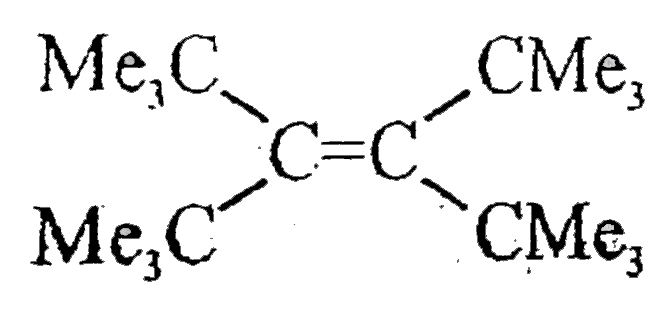The species which will not show hyperconjugation is
CH3C+H2
(CH3)3CC+H2
CH3CH2C+H2
CH3C+HCH2
The correct Answer is:B
To determine which species will not show hyperconjugation, we need to understand the concept of hyperconjugation itself. Hyperconjugation is the interaction between the electrons in a σ-bond (usually C-H or C-C) and an adjacent empty or partially filled p-orbital or π-bond. This interaction stabilizes the molecule.
1. Identify the Requirement for Hyperconjugation:
Hyperconjugation requires the presence of a carbon atom that is sp³ hybridized and has at least one adjacent carbon atom with a hydrogen atom (alpha hydrogen).
Hint: Look for sp³ hybridized carbons and adjacent hydrogens.
2. Analyze Each Given Species:
- Option A: Check if it has sp³ hybridized carbons and alpha hydrogens.
- Option B: Check the same conditions as above.
- Option C: Repeat the analysis.
- Option D: Continue checking for sp³ hybridization and alpha hydrogens.
3. Determine Which Species Lacks Alpha Hydrogens:
- If any of the species lack sp³ hybridized carbons or do not have adjacent alpha hydrogens, they will not exhibit hyperconjugation.
Hint: Focus on the structure of each option to find the one without alpha hydrogens.
4. Conclude:
After analyzing all options, identify the species that does not meet the criteria for hyperconjugation. This will be the answer to the question.
Hint: The answer will be the option that does not have the required structure for hyperconjugation.
Final Answer:
The species that will not show hyperconjugation is the one that lacks sp³ hybridized carbons or adjacent alpha hydrogens.
Hyperconjugation requires the presence of a carbon atom that is sp³ hybridized and has at least one adjacent carbon atom with a hydrogen atom (alpha hydrogen).
- Option A: Check if it has sp³ hybridized carbons and alpha hydrogens.
- Option B: Check the same conditions as above.
- Option C: Repeat the analysis.
- Option D: Continue checking for sp³ hybridization and alpha hydrogens.
- If any of the species lack sp³ hybridized carbons or do not have adjacent alpha hydrogens, they will not exhibit hyperconjugation.
After analyzing all options, identify the species that does not meet the criteria for hyperconjugation. This will be the answer to the question.
The species that will not show hyperconjugation is the one that lacks sp³ hybridized carbons or adjacent alpha hydrogens.
Topper's Solved these Questions
Similar Questions
Hyperconjugation describes the orbital interactions between the π-system and the adjacent σ-bond of the substituent group(s) in organic compounds. Hyperconjugation is called as Baker and Nathan effect. The necessary and sufficient conditions for the hyperconjugation are:
(i) Compound should have at least one sp2-hybrid carbon of either alkene, carbocation or alkyl free radical.
(ii) α-carbon with respect to sp2 -hybrid carbon should have at least one hydrogen.
Hyperconjugation are of three types:
(i) σ(C−H),π-conjugation,
(ii) σ(C−H), positive charge conjugation,
(iii) σ(C−H), odd electron conjugation.
The hyperconjugation may be represented as,


Number of resonating structures due to hyperconjugation =(n+1), where n is the numebr of α-hydrogen. Greater is the number of such forms, more is the stability of the species under consideration.
Hyperconjugation is possible in which of the following species?
View SolutionIn which molecules or ions hyperconjugation effect is observed and write the number of hyperconjugable hydrogen atoms.

View Solution
Knowledge Check
Which will show hyperconjugation?
AH2C−CH=C∣−B C
C D
D
Hyperconjugation involves
ADelocalization of σ-electrons into an adjacent π-bondBDelocalization of n-electrons into an adjacent double bondCDelocalization of π-electrons into an adjacent π-bondDAll are true.Out of following which will show hyperconjugation:-
A BCH3−Ph∣C∣CH3−⊕CH2C
BCH3−Ph∣C∣CH3−⊕CH2C DAll
DAll
Hyperconjugation describes the orbital interactions between the π-system and the adjacent σ-bond of the substituent group(s) in organic compounds. Hyperconjugation is called as Baker and Nathan effect. The necessary and sufficient conditions for the hyperconjugation are:
(i) Compound should have at least one sp2-hybrid carbon of either alkene, carbocation or alkyl free radical.
(ii) α-carbon with respect to sp2 -hybrid carbon should have at least one hydrogen.
Hyperconjugation are of three types:
(i) σ(C−H),π-conjugation,
(ii) σ(C−H), positive charge conjugation,
(iii) σ(C−H), odd electron conjugation.
The hyperconjugation may be represented as,


Number of resonating structures due to hyperconjugation =(n+1), where n is the numebr of α-hydrogen. Greater is the number of such forms, more is the stability of the species under consideration.
Which of the following free redicals will not show the phenomena of hyperconjugation?
View SolutionThe species which does not show paramagnetism is .
View SolutionThe species which does not show paramagetism is :
View SolutionWhich of the following species is/are stabilised hyperconjugation ?
View SolutionAmong the following which is true about Hyperconjugation?
View Solution
